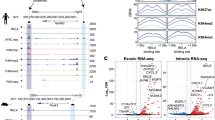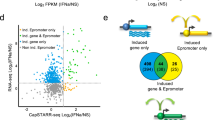Abstract
Nucleotide-binding and oligomerization domain 2 (NOD2), a member of the NOD protein family, plays an important role in innate immunity. In response to pathogen attack, NOD2 stimulates cytokine and defensin production by activating nuclear factor (NF)-κB, a key transcription factor responsible for mediating downstream reactions. However, the mechanism linking NOD2 regulation and NF-κB activation is poorly understood. Using bioinformatics, we found a completely preserved canonical NF-κB binding site in the NOD2 core promoter (−16 to −25 bp) in both humans and chimpanzees. The functional role of this NF-κB binding site was investigated using the enhanced green fluorescent protein (EGFP) reporter system, site-directed mutagenesis, the NF-κB activation inhibitor (JSH-23) and the chromatin immunoprecipitation (ChIP) assay. The results show that the NF-κB binding site is critical for regulation of the NOD2 gene. Either deletion of the NF-κB binding elements within the NOD2 promoter or treatment with an NF-κB activation inhibitor could lead to a significant loss of NOD2 promoter activity as detected by reporter gene assay. The canonical NF-κB binding site was bound by NF-κB as determined by the ChIP method. Based on these results, we suggest a positive feedback regulation between NF-κB and NOD2, which may represent an efficient mechanism in response to pathogen invasion.
This is a preview of subscription content, access via your institution
Access options
Subscribe to this journal
Receive 12 digital issues and online access to articles
$119.00 per year
only $9.92 per issue
Buy this article
- Purchase on Springer Link
- Instant access to full article PDF
Prices may be subject to local taxes which are calculated during checkout





Similar content being viewed by others
References
Heine H, Ulmer AJ . Recognition of bacterial products by Toll-like receptors. Chem Immunol Allergy 2005; 86: 99–119.
Murray PJ . NOD proteins: an intracellular pathogen-recognition system or signal transduction modifiers? Curr Opin Immunol 2005; 17: 352–358.
Proell M, Riedl SJ, Fritz JH, Rojas AM, Schwarzenbacher R . The Nod-like receptor (NLR) family: a tale of similarities and differences. PLoS One 2008; 3: e2119.
Fritz JH, Ferrero RL, Philpott DJ, Girardin SE . Nod-like proteins in immunity, inflammation and disease. Nat Immunol 2006; 7: 1250–1257.
Girardin SE, Travassos LH, Hervé M, Blanot D, Boneca IG, Philpott DJ et al. Peptidoglycan molecular requirements allowing detection by Nod1 and Nod2. J Biol Chem 2003; 278: 41702–41708.
Kufer TA, Banks DJ, Philpott DJ . Innate immune sensing of microbes by Nod proteins. Ann NY Acad Sci 2006; 1072: 19–27.
Inohara N, Nunez G . NODs: intracellular proteins involved in inflammation and apoptosis. Nat Rev Immunol 2003; 3: 371–382.
Inohara N, Nuñez G . The NOD: a signalling molecular that regulates apoptosis and host defense against pathogens. Oncogene 2001; 20: 6473–6481.
Tanabe T, Chamaillard M, Ogura U, Zhu L, Qiu S, Masumoto J et al. Regulatory regions and critical residues of NOD2 involved in muramyl dipeptide recognition. EMBO J 2004; 23: 1587–1597.
Wilmanski JM, Petnicki-Ocwieja T, Kobayashi KS . NLR proteins: integral members of innate immunity and mediators of inflammatory diseases. J Leukoc Biol 2008; 83: 13–30.
Kufer TA, Fritz JH, Philpott DJ . NACHT-LRR proteins (NLRs) in bacterial infection and immunity. Trends Microbiol 2005; 13: 381–388.
Abbott DW, Wilkins A, Asara JM, Cantley LC . The Crohn's disease protein, NOD2, requires RIP2 in order to induce ubiquitinylation of a novel site on NEMO. Curr Biol 2004; 14: 2217–2227.
Beutler B . Inferences, questions and possibilities in Toll-like receptor signalling. Nature 2004; 430: 257–263.
Kawai T, Akira S . Signaling to NF-kappaB by Toll-like receptors. Trends Mol Med 2007; 13: 460–469.
Shaw MH, Reimer T, Kim YG, Nuñez G . NOD-like receptors (NLRs): bona fide intracellular microbial sensors. Curr Opin Immunol 2008; 20: 377–382.
Voss E, Wehkamp J, Wehkamp K, Stange EF, Schröder JM, Harder J . NOD2/CARD15 mediates induction of the antimicrobial peptide human beta-defensin-2. J Biol Chem 2006; 281: 2005–2011.
Rosenstiel P, Jacobs G, Till A, Schreiber S . NOD-like receptors: ancient sentinels of the innate immune system. Cell Mol Life Sci 2008; 65: 1361–1377.
Benson DA, Karsch-Mizrachi I, Lipman DJ, Ostell J, Sayers EW . GenBank. Nucleic Acids Res 2009; 37: D26–D31.
Huang E, Yang L, Chowdhary R, Kassim A, Bajic VB . An algorithm for ab initio DNA motif detection. In: Proceedings of the Information Processing and Living Systems. Singapore: World Scientific Press, 2005: 611–614.
Janecki AJ, Janecki M, Akhter S, Donowitz M . Quantitation of plasma membrane expression of a fusion protein of Na/H exchanger NHE3 and green fluorescence protein (GFP) in living PS120 fibroblasts. J Histochem Cytochem 2000; 48: 1479–1492.
Juven-Gershon T, Hsu JY, Theisen JW, Kadonaga JT . The RNA polymerase II core promoter – the gateway to transcription. Curr Opin Cell Biol 2008; 20: 253–259.
Yang W, Ng P, Zhao M, Wong TK, Yiu SM, Lau YL . Promoter-sharing by different genes in human genome – CPNE1 and RBM12 gene pair as an example. BMC Genomics 2008; 9: 456.
Bunting K, Rao S, Hardy K, Woltring D, Denyer GS, Wang J et al. Genome-wide analysis of gene expression in T cells to identify targets of the NF-kappa B transcription factor c-Rel. J Immunol 2007; 178: 7097–7109.
Uddin M, Wildman DE, Liu G, Xu W, Johnson RM, Hof PR et al. Sister grouping of chimpanzees and humans as revealed by genome-wide phylogenetic analysis of brain gene expression profiles. Proc Natl Acad Sci USA 2004; 101: 2957–2962.
Rosenstiel P, Fantini M, Bräutigam K, Kühbacher T, Waetzig GH, Seegert D et al. TNF-alpha and IFN-gamma regulate the expression of the NOD2 (CARD15) gene in human intestinal epithelial cells. Gastroenterology 2003; 124: 1001–1009.
Iber H . Chen Q, Cheng PY, Morgan ET. Suppression of CYP2C11 gene transcription by interleukin-1 mediated by NF-kappaB binding at the transcription start site. Arch Biochem Biophys 2000; 377: 187–194.
Ogura Y, Inohara N, Benito A, Chen FF, Yamaoka S, Nunez G . Nod2, a Nod1/Apaf-1 family member that is restricted to monocytes and activates NF-kappaB. J Biol Chem 2000; 276: 4812–4818.
Acknowledgements
We thank Professor Yubing Zhou (Medical College of Jinan University) for her guidance and technical assistance. Our authors also appreciate the valuable discussion and amendment made by Dr Kum-heng Poon (Health Canada). This work was supported by grants from the Natural Science Foundation of Guangdong Province (No. 06025159) and the Natural Science Foundation from Department of Education of Guangdong Province (No. 126 (2005)).
Author information
Authors and Affiliations
Rights and permissions
About this article
Cite this article
Hu, C., Sun, L., Hu, Y. et al. Functional characterization of the NF-κB binding site in the human NOD2 promoter. Cell Mol Immunol 7, 288–295 (2010). https://doi.org/10.1038/cmi.2010.16
Received:
Revised:
Accepted:
Published:
Issue Date:
DOI: https://doi.org/10.1038/cmi.2010.16
Keywords
This article is cited by
-
IL-1α and IL-1β promote NOD2-induced immune responses by enhancing MAPK signaling
Laboratory Investigation (2019)
-
TRPM8 in the negative regulation of TNFα expression during cold stress
Scientific Reports (2017)
-
Role of NOD2 in regulating the immune response to Aspergillus fumigatus
Inflammation Research (2012)
-
A review of major Crohn’s disease susceptibility genes and their role in disease pathogenesis
Genes & Genomics (2011)



